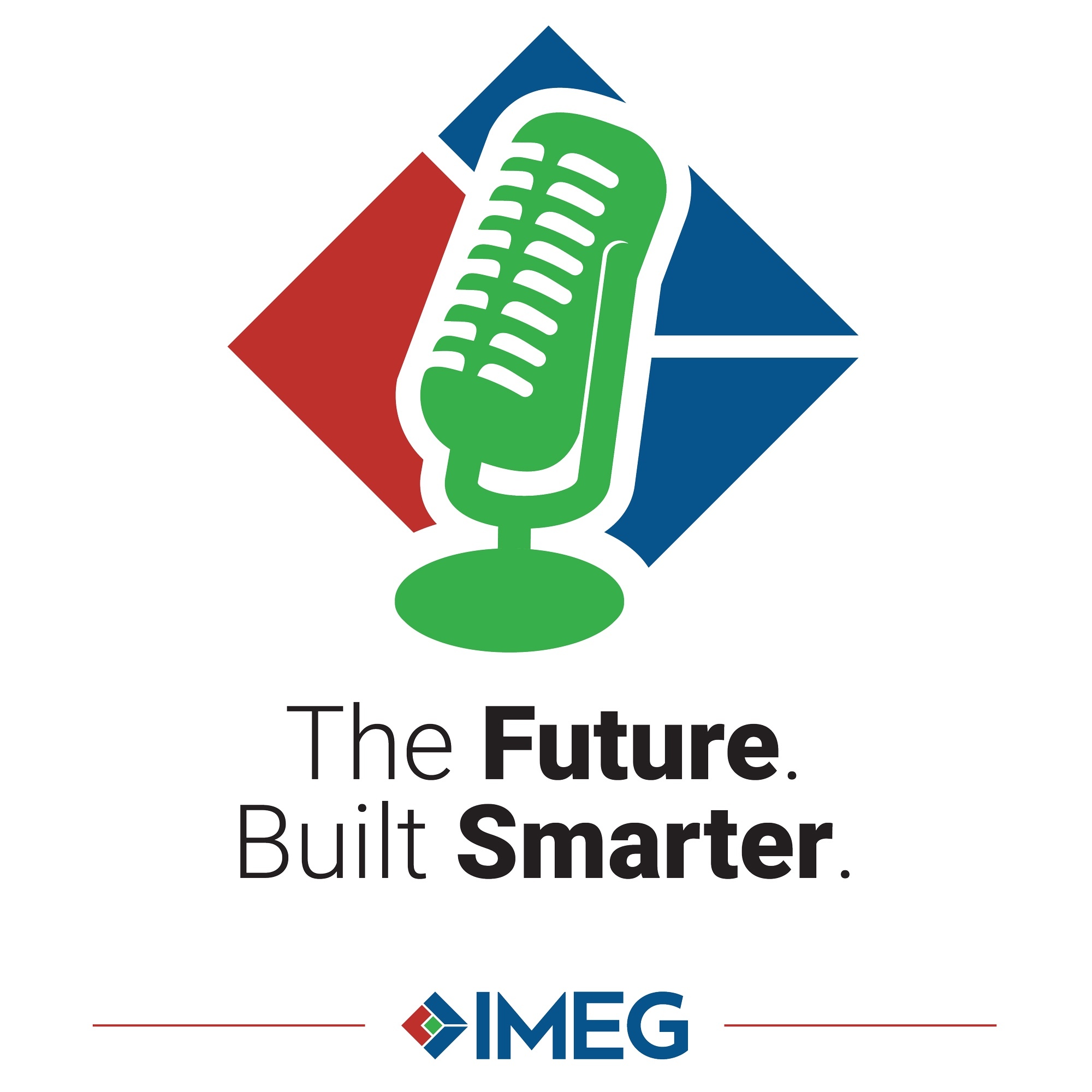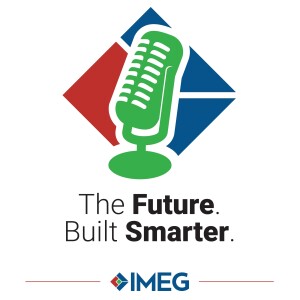
7.8K
Downloads
63
Episodes
Engineers and designers from IMEG, a top 5 U.S. engineering firm, discuss innovative and trend-setting building and infrastructure design with architects, owners, and others in the AEC industry. Topics touch on all market sectors, engineering disciplines, and related services.
Episodes

Thursday Mar 03, 2022
The Quadruple Aim & the Built Environment, Part 2: Improving Population Health
Thursday Mar 03, 2022
Thursday Mar 03, 2022
Numerous healthcare organizations have adopted the guiding principles of the Quadruple Aim—a framework for healthcare excellence, the goals of which can be greatly supported through an intentionally designed built environment. In the second of a series of episodes based on the executive guide, “Enhancing the Quadruple Aim through Data-Driven Decisions in the Built Environment,” IMEG Director of Sustainability Adam McMillen discusses how the built environment can help healthcare organizations achieve the first goal, improving population health.

Wednesday Feb 16, 2022
The Quadruple Aim & the Built Environment, Part 1: Healthcare’s Dynamic Duo
Wednesday Feb 16, 2022
Wednesday Feb 16, 2022
Numerous healthcare organizations have adopted the guiding principles of the Quadruple Aim, a framework for healthcare excellence that focuses on improving population health, reducing the cost of care, enhancing the patient experience, and improving provider satisfaction. Many of these organizations, however, are missing out on opportunities to support these desired outcomes through an intentionally designed built environment. In the first of a series of episodes based on the executive guide, “Enhancing the Quadruple Aim through Data-Driven Decisions in the Built Environment,”IMEG Director of Healthcare Mike Zorich provides a high-level explanation of the Quadruple Aim and offers examples of various design strategies and elements that can enhance it—and ultimately help the healthcare industry deliver better outcomes for patients, caregivers, communities, and the world.

Wednesday Nov 24, 2021
5 steps to begin the process of decarbonizing your building
Wednesday Nov 24, 2021
Wednesday Nov 24, 2021
In the final episode in our series on sustainability strategies of the future, IMEG Director of Sustainability Adam McMillen discusses five steps any owner can take to begin the process of decarbonizing their building. “There's a lot of discussion today about decarbonizing — the push to make sure we all electrify our buildings because the grid will get cleaner in the future. This is a big change, and a lot of owners are wondering how to wade into it without a lot of risk,” says McMillen. “So, we’re summarizing five things owners can do today that don't cost a lot of money and that will help ensure their buildings will be ready for electrification—whether it's a new building, or even an existing building that's undergoing a major renovation.”

Monday Nov 01, 2021
Battery storage: Clean energy for a rainy day — and peak demand relief
Monday Nov 01, 2021
Monday Nov 01, 2021
Battery energy storage is examined in part five of our series on sustainability strategies of the future. “Most of us in the industry have had a lot of questions about batteries,” says IMEG Director of Sustainability Adam McMillen. “When does it make sense? When will they be cost competitive? How do they fit into the big picture? These are all good questions because the last thing you want to do is put some expensive, embodied-carbon heavy, lithium-ion batteries on your campus and then have them not really do much for you.” Co-host Mike Lawless, IMEG Direction of Innovation, joins Adam in delving into these questions. They also discuss the many future opportunities of this strategy, such as pairing batteries with renewables such as wind and solar to provide facilities with both reliable and sustainable backup power when the grid goes down as well as a method to eliminate expensive peak demand charges from utilities.
Battery energy storage is examined in part five of our series on sustainability strategies of the future. “Most of us in the industry have had a lot of questions about batteries,” says IMEG Director of Sustainability Adam McMillen. “When does it make sense? When will they be cost competitive? How do they fit into the big picture? These are all good questions because the last thing you want to do is put some expensive, embodied-carbon heavy, lithium-ion batteries on your campus and then have them not really do much for you.” Co-host Mike Lawless, IMEG Direction of Innovation, joins Adam in delving into these questions. They also discuss the many future opportunities of this strategy, such as pairing batteries with renewables such as wind and solar to provide facilities with both reliable and sustainable backup power when the grid goes down as well as a method to eliminate expensive peak demand charges from utilities.

Monday Nov 01, 2021
Call in the reserves: Thermal energy storage to the rescue
Monday Nov 01, 2021
Monday Nov 01, 2021
The fourth episode in our series on sustainability strategies of the future examines thermal energy storage. To illustrate, consider hospitals and industrial facilities that use heat pumps to create the large amount of heating hot water needed for their buildings. This type of heat pump can’t operate when temperatures dip below 15 degrees, however, and a gas-burning boiler is typically used as back-up. Thermal energy storage provides a carbon-free alternative. In this strategy, the heat pump generates additional heating water during the warmer part of the day and stores it in a thermal energy storage tank. That water can then be used to heat the facility during frigid overnight hours or anytime the temperature dips below 15 degrees and the heat pumps shut down. Conversely, chilled water storage in the summer months enables facilities to shut down their chillers in the hot afternoon hours and cool the building with water saved overnight to shave off peak demand charges. IMEG Director of Sustainability Adam McMillen discusses the challenges, solutions, and many opportunities of this new strategy.

Wednesday Oct 13, 2021
3-2-1: How commercialization launched IMEG into the aerospace industry
Wednesday Oct 13, 2021
Wednesday Oct 13, 2021
This episode takes a brief look at how the commercialization of the aerospace industry has opened the doors for more engineering firms to become engaged in such projects. Guest Ed Dean, an IMEG structural engineer who has designed several launch facility projects, discusses how IMEG entered the market, and the benefits commercially oriented firms bring to aerospace clients. “Commercial buildings and structures are not done in an institutional way, but rather on a very rapid schedule; things are very much fast-tracked and you’re delivering certain ‘just-in-time’ design elements. We apply this approach to the design of launch facilities, saving clients both time and money.” Ed also talks about being on site for launches and discusses a mock rocket IMEG designed to allow a client to test their launch facility equipment and processes prior to an actual rocket launch.

Thursday Sep 23, 2021
Cold Climate Electrification: A Path Toward ‘Clean’ Heating
Thursday Sep 23, 2021
Thursday Sep 23, 2021
In the third episode of our series on sustainability strategies of the future, IMEG’s Adam McMillen discusses cold climate electrification. Essentially, this is a means to providing heat in cold climates without burning carbon-emitting fossil fuels. In areas with cold winters, McMillen explains, we currently use natural gas-burning furnaces or boilers for heat. Electricity, however, is used to power our cooling systems in the warmer months. While electricity is produced predominately by coal-burning plants, there is a trend by utilities toward greater use of renewable energy as a source. “We see our electric grid getting cleaner, year after year,” says McMillen. “So, imagine a future in which our grid is fully clean, and instead of using fossil-fueled boilers we’re using some sort of electrically-based heating equipment. As a result, we would then have perfectly clean heating and cooling for our homes and our businesses.”

Monday Sep 20, 2021
The Chiller Reality: Your MEP Equipment is Full of Embodied Carbon
Monday Sep 20, 2021
Monday Sep 20, 2021
In the second episode of our series on sustainability strategies of the future, IMEG’s Adam McMillen discusses embodied carbon in chillers, boilers, and other MEP equipment. “Naturally, engineers put a lot of equipment into buildings,” he says. “That equipment contains a lot of steel and comes from all over the world, so it obviously has a carbon footprint.” Quantifying that footprint is critical. “It’s starting to become clear that the amount of carbon a company has on its books is going to be a liability in the future, from a climate change perspective, a dollar perspective, and a regulations perspective. We need to get all this quantified so that companies can clearly see these big numbers as a risk to their business and demand lower levels from manufacturers.” Reversing the “throw-away” mentality also is crucial and includes designing buildings for a much longer life. “Let’s not think about constructing a 50-year building — let’s think about a 100-year building,” McMillen says. “And let’s think about 30-year MEP equipment.”

Monday Sep 13, 2021
Embodied Carbon: In the Crosshairs of Designers, Bill Gates, and Girl Scouts
Monday Sep 13, 2021
Monday Sep 13, 2021
In the first of a series on sustainability strategies of the future, IMEG Director of Sustainability Adam McMillen discusses embodied carbon. “We have pretty much figured out how to reduce operational carbon,” he says. “Now the AEC industry is ready for the next step — reducing embodied carbon in steel, concrete, and wood.” Getting these materials to a construction site requires extraction or harvesting, processing, and transportation — each of which requires energy, mostly from burning fossil fuels, which in turn releases CO2. These emissions combined make up the carbon footprint, or the embodied carbon, of a material. “People in the industry and elsewhere are really starting to get it,” says McMillen, who counts Bill Gates and Wisconsin Girl Scouts among those who are helping to spread the word. Learn more in this 15-minute podcast.

Tuesday Aug 24, 2021
Tuesday Aug 24, 2021
With legalized medical and recreational marijuana continuing to expand across the U.S., many new grow facilities will be licensed and constructed in the coming years. This episode examines important infrastructure considerations that are critical for “keeping the plants happy” and achieving successful harvests — not only for cannabis but also for other crops grown within controlled environment agriculture (CEA) facilities. “Our experience designing these facilities allows us to provide valuable information and lessons learned for owners who will be venturing into this market for the first time,” says IMEG’s Luke Streit, a project manager for several cannabis grow facilities. Luke discusses a variety of topics during this episode, including water and energy use, HVAC systems, power requirements, and other unique challenges encountered by CEA owners. Based on a recent IMEG webinar, this podcast provides valuable information for owners and architects alike.
